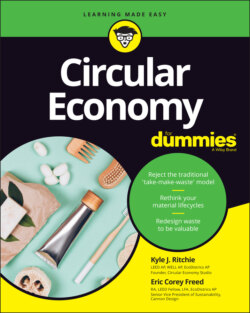Читать книгу Circular Economy For Dummies - Eric Corey Freed - Страница 98
Building Resilience Through Diversity: Redefining Strength
ОглавлениеIn the modern business economy, a strong business is seen as one that brings in a lot of money. Having that money on hand provides the company with the power to essentially buy its way out of trouble. Although having money in the bank is indeed a strength of a business, it’s limited in its value when responding to change. Having a lot of resources isn’t always the answer, but having the capacity to respond to change is. Having a bunch of cash is useful, but not if you’re stranded on a desert island.
When addressing the resilience of the circular economy, it’s critical to understand that diversity plays a major role — diversity of products, of manufacturing processes, of sources, of customers, and of partners. If you have a retirement account set up through your employer or you voluntarily walked down to an independent investor and opened a Roth IRA, you’ll see that a similar safeguarding practice is taking place. Pull up your 401K account right now and you’ll see that your investments are distributed among different investment categories rather than just one. Brokers do that to ensure that a collapse in one area doesn’t destroy your entire retirement fund. Do you remember that old saying, “Don’t put all your eggs in one basket”?
Within the circular economy, diversity is achieved by creating products that are modular, versatile, and adaptable to different applications. It’s important to understand, however, that in order to develop an effective, well-functioning system, diversity and efficiency need to find a balance. The most efficient product lifecycles will have very few nodes or areas of connections, but will be much more vulnerable to any severe changes that may occur. If, for example, a restaurant has only one available produce supplier and that farmer’s supply gets destroyed, so does the restaurant owner’s business. On the other hand, product lifecycles with low levels of efficiency and a diverse level of connections have multiple nodes and will be well prepared to respond to severe changes. If the same restaurant owner had multiple produce suppliers, one farmer’s misfortune wouldn’t destroy the restaurant owner’s business.
If you look toward the natural world as the prime example of the circular economy in practice, you see that diversity is one of the natural world’s key design principles. In permaculture — a design framework that guides the design of ecosystems intended to be sustainable and self-sufficient — you can see that use-and-value-diversity is one of the design principles extracted from the natural world. (For more details on the permaculture concept, see Chapter 15.) The innate goal of the natural world is to preserve the opportunity for tomorrow. “Only the strong survive” and “survival of the fittest” —both sayings suggest that the individual elements of a system that survive over time are strong and durable, and fit in with their surroundings. Why can’t the global economy act in a similar fashion? In the future, when we move away from monocultures (planting one type of crop throughout an entire field) and move toward polycultures (planting many plants throughout an entire field), we’ll see that the resilience of these fields will be stronger and they’ll have the ability to bounce back from any natural or human-caused disruptions.
